Cerveteri › Iliad » Ancient origins
Articles and Definitions › Contents
- Cerveteri › Who Was
- Iliad › Antique Origins
Ancient civilizations › Historical and archaeological sites
Cerveteri › Who Was
Definition and Origins
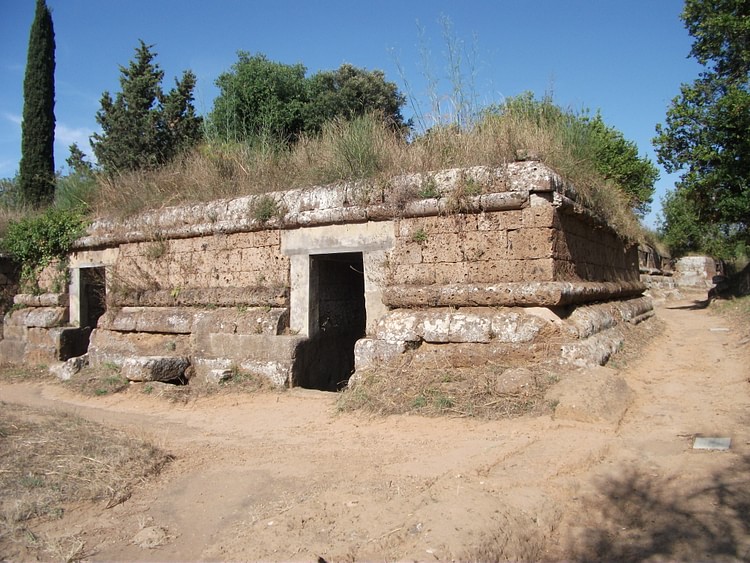
Cerveteri ( Etruscan name: Cisra or Caisra, Greek : Agylla, Roman : Caere) was an important Etruscan town which flourished between the 7th and 4th century BCE. Located near the western coast of central Italy, around 50 km north of Rome, Cerveteri is today most famous for its thousands of rock-cut tombs which were rich in artefacts and wall paintings depicting scenes from Etruscan daily life. Outstanding among these is the Regolini-Galassi tomb, found chock-full of precious artefacts from silver cups to the finest Etruscan gold jewellery ever discovered.
EARLY SETTLEMENT
Cerveteri, located on a tufa outcrop overlooking the Tyrrhenian Sea, has archaeological evidence of settlement from the Bronze Age and has cemeteries which date back to the Iron Age. Many of these latter burials contain instruments related to wool working such as spools, spindles and loom weights made of pottery and, less frequently, bronze. Blessed with fertile land for agriculture, mineral resources in the nearby Tolfa Mountains, and beginning to exchange goods with neighbours such as Tarquinia, Cerveteri was a thriving settlement of the pre- Etruscan culture known as the Villanovan (1000-750 BCE) and was set to become a prosperous town in the Etruria region of central Italy.
A THRIVING ETRUSCAN CITY
From the 7th century BCE, Cerveteri was an important production centre for the indigenous bucchero pottery (perhaps even the first, c. 675 BCE), which has a glossy dark grey, almost black finish, as well as wares imitating Greek (especially Ionian) and Near Eastern styles, sometimes made by Greek immigrant artists. The town's workshops produced its own distinctive vase shape, the Caeretan hydria, a large two-handled vessel used for holding water and often decorated with scenes from Greek and Etruscan mythology. Evidence of Cerveteri's position as a trade centre takes the form of the many fine Greek vases found at the site. The general prosperity of the city's elite is evidenced in the large tombs and their contents, placed within tumuli and set in orderly rows along streets. By the 6th century BCE, city covered some 150 hectares and was creating colonies of its own such as at Tolfa.
CERVETERI IS THE ONLY KNOWN ETRUSCAN CITY TO HAVE HAD ITS OWN TREASURY AT DELPHI, INDICATIVE OF ITS STATUS AS ONE OF THE RICHEST MEMBERS OF THE ETRUSCAN LEAGUE.
Etruscan Cerveteri is the only known city of that culture to have had its own treasury at the sacred site of Delphi in Greece, indicative of its status as one of the richest members of the Etruscan League. It had three ports: Alsium, Punicum, and Pyrgi with its two grand temples and sanctuary. One of these temples had three gold plaques nailed to its door, which were dedicated by a king of Cerveteri called Thefarie Velianas. The inscriptions, dating to around 500 BCE, were written in both Etruscan and Phoenician, again indicating the town's role as an international trade centre.
Cerveteri was a member of the Etruscan League, a loose confederacy of 12 (or perhaps 15) Etruscan towns. They included Chiusi, Populonia, Tarquinia (Tarchuna), Vulci (Velch) and Volterra. Very little is known of this league except that its members had common religious ties and that leaders met annually at the Fanum Voltumnae sanctuary near Orvieto (exact location as yet unknown). That Cerveteri was one of the most advanced Etruscan cities and something of a trendsetter is evidenced in finds of some of the earliest pottery, artwork, and inscriptions produced in the region of Etruria.
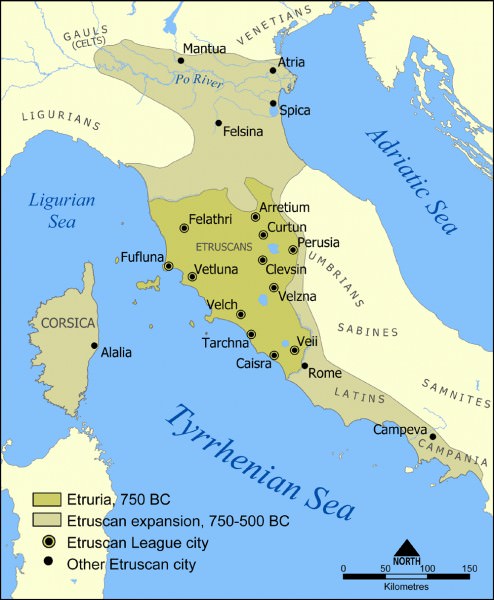
Etruscan Civilization
DECLINE & ROMAN CONQUEST
Cerveteri's interests were safeguarded following a naval victory in the Battle of Alalia (aka Battle of the Sardinian Sea) in 540 BCE. Allied with a Carthaginian force, they saw off a fleet of the Phocaeans. According to Herodotus (1:167), some of the Greek survivors were taken to Cerveteri and brutally stoned to death. There then followed a curse of paralysis on anyone who went near the spot of this tragedy. Seeking to allay the curse the rulers of Cerveteri consulted the oracle at Delphi and were told to hold athletic games in honour of the dead. This they did, says Herodotus, and continued to do so regularly thereafter.
A period of decline set in, though, from the mid-5th century BCE as control of the lucrative local trade routes fell into the hands of Sicily 's rising power Syracuse. The loss of the naval battle at Cumae in 474 BCE was the beginning of a slow decline.Then the Syracusan tyrant Dionysius I, no doubt remembering the Etruscan support of Athens ' attack on his city 30 years before, sent an expedition to central Italy to grab what riches it could. The ports of Cerveteri were sacked and the temples robbed of their treasures in 384 BCE. Further Syracusan attacks would hit Etruria in the following decades. Even worse was to come, however, when the Etruscan's southern neighbours started to show more territorial ambition too: the Romans were coming.
The Romans would exploit the lack of political and military unity between the Etruscan League members and eventually take over all of the Etruscan cities. Cerveteri had actually been a loyal ally of Rome, giving a safe haven for the Vestal Virgins, for example, when the Gauls had attacked Rome in the 4th century BCE. The cultural and military march of the Romans would stop for no one, though, and Cerveteri was assimilated into the Republic along with its fellow Etruscan cities after a long and bloody conflict punctuated by periods of peace. A Roman maritime colony was established at Pyrgi, and by the early 2nd century BCE Cerveteri's ultimate Romanisation included the granting of Roman citizenship, several building projects including a theatre, and the imposition of further Roman colonies in Cerveteri's former territories. Cerveteri became something of a cultural backwater, dedicating itself to agriculture and the production of cloth and rope. Gone forever were its glory days as one of the liveliest cultural centres of the ancient Mediterranean.
ARCHAEOLOGICAL REMAINS
To the south of the city, the foundations of two large temples have been excavated. Both dating to the 6th century BCE, one may have been dedicated to Hercules, if the presence of an inscribed cup and several clubs are taken as evidence of votive offerings to the god. Similarly, a lead weight inscribed with the Etruscan word for Hermes ( Turms ) may indicate the deity of the second temple. A third large structure, known as the Manganello temple, had a tufa block base, cisterns, water channels, wells, and a furnace, perhaps as part of workshop manufacturing votive goods.
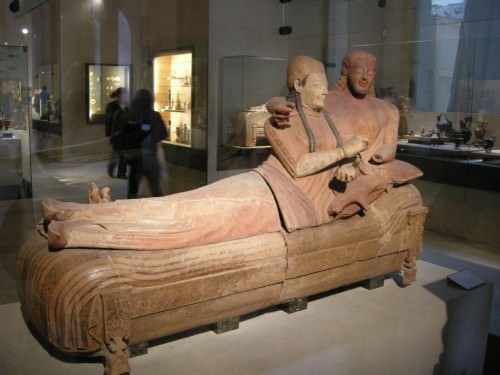
Sarcophagus of the Married Couple, Cerveteri
The thousands of rock-cut chamber tombs at Cerveteri are distributed over several cemeteries, the Banditaccia, Cava Della Pozzolana, Monte Abatone, and Sorbo, the latter dating back to the Iron Age. The earliest Etruscan tombs date to the 7th century BCE. Many are tumuli, that is grass and earth mounds covering a rock base, either made from blocks or cut out of natural outcrops. The largest are over six metres in diameter. Other kinds of tombs are the distinctive cube-like structures in the Banditaccia necropolis. These, dating from the mid-6th century BCE, are made from large stone blocks and, again, incorporate natural rocks; each has a single doorway entrance, and inside are stone benches on which the deceased were laid, carved altars, and sometimes stone seats. Set in rows, the tombs perhaps indicate a greater concern with town-planning at that time.
Unlike the tombs at Tarquinia, for example, many of the wall paintings at Cerveteri were applied directly to the stone walls without a plaster underlayer. This has meant that they have deteriorated much more than at other Etruscan sites.Nevertheless, there are still some fine examples of Etruscan art. Scenes commonly show Greek myths, animals, and daily life.
The splendid Tomb of the Stucco Reliefs was constructed for the Matuna family during the last quarter of the 4th century BCE.It is accessed via a steep stepped corridor which opens into a chamber with stone benches on all sides and places for 32 bodies. The chamber's two columns and walls are covered in painted stucco depictions of everyday objects from tools to boardgames. The objects hang from nails in imitation of the typical Etruscan household where storage cabinets are largely unknown and possessions were hung from the walls.
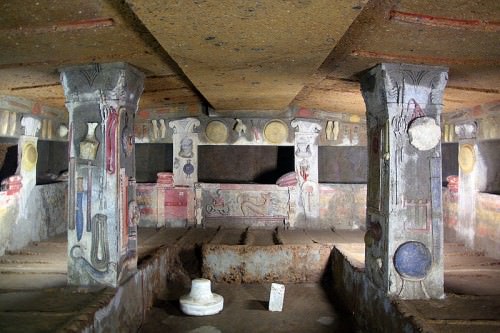
Tomb of the Reliefs, Cerveteri
Objects from the tombs of Cerveteri include many examples of exquisite gold jewellery pieces – bracelets, buckles, earrings, rings, pins, necklaces, and pendants – many of which display the most difficult goldwork techniques. There are buccherowares, painted pottery (both locally produced and imported, especially from Corinth and Athens), terracotta sculptures, and sarcophagi decorated with relief sculptures. One outstanding example of the latter, now in the Louvre museum, has a married couple figure sculpture on its lid and dates to c. 530-520 BCE. The terracotta coffin contained a cremation and was once brightly painted. Finally, many tombs contained painted terracotta plaques depicting scenes from mythology, especially.Fragments of these found scattered across Cerveteri would suggest that they were also used to decorate the interiors of private houses and public buildings.
THE REGOLINI-GALASSI TOMB
The most spectacular tomb in terms of finds at Cerveteri is the Tomba Regolini-Galassi, named after the priest and general, respectively, who discovered it in 1836 CE. The pair discovered the tomb intact and came face to face with the skeleton, bedecked in fine jewellery, of the tomb's female occupant. She wore a gold pectoral 42 cm across decorated with animals and plants, a symbol of her high social status. The woman also wore a belt with a magnificent gold fibula made with repoussé and granulation techniques. It is decorated with five lions on its upper disk and 50 minute ducks in three-dimensions on the lower disk. Whatever the role of this person was in life, we do know her name, Larthia, inscribed on an eleven-piece silver service set found at her feet. Neither was she interred alone in the tomb, for there was a second chamber containing the ashes of a male.
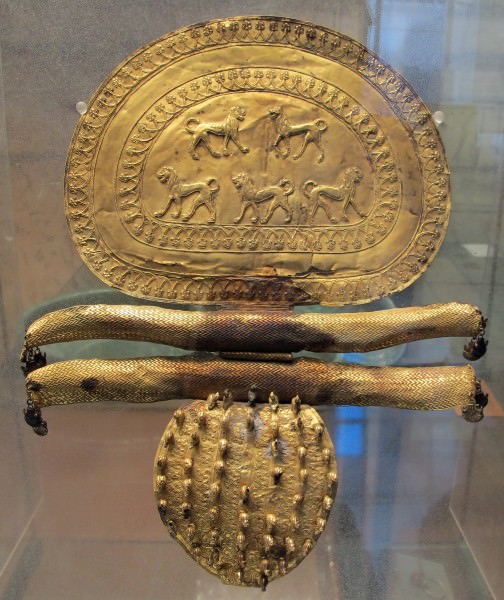
Etruscan Gold Fibula, Cerveteri
Other items in the tomb, many with near Eastern-like decoration include a large bronze couch; round shields, incense burners, cauldrons, and a throne in the same material; silver cups and dishes; and bucchero wares in the form of bowls, pitchers, and beakers. There were large terracotta vases which once contained food for the deceased (wheat, oil, honey, and eggs). Finally, there was a four-wheeled bed-carriage on which lay the woman of the tomb and another two-wheeled chariot. The contents of the tomb, dated to c. 680-660 BCE, can be seen today in its own dedicated room in the Vatican Museums, Rome.
MAP
Iliad › Antique Origins
Definition and Origins
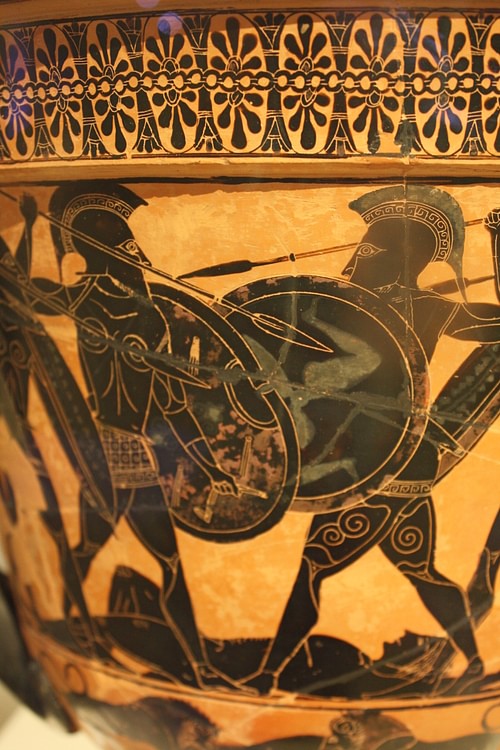
Homer 's Iliad describes the final year of the Trojan War, a legendary conflict between an alliance of Greek cities and the city of Troy in Anatolia. It was probably written sometime in the 8th century BCE after a long oral tradition, but the Greeks themselves imagined the war to have occurred sometime in the 13th century BCE during the Bronze Age. The Greeks thought Homer was from Chios or Ionia and credited him with both the Iliad and Odyssey, the two masterpieces of Greek literature.They also thought him the greatest ever writer and referred to him simply as 'the poet.'
The Iliad is universally acclaimed as a truly great story. There is war and gore, honour and betrayal, pain and pathos, love and hatred, a good few villains and even more heroes, all set in the good old days of a glorious but not forgotten past. Above all, the Iliad presents the tragic yet thrilling reality of humanity's mortality, and as the events unfold, we are ever reminded that our lives are shaped and buffeted by the winds of Fate from which even the central character Achilles, magnificent warrior that he is, cannot escape.
BACKGROUND
The Iliad, written sometime in the 8th century BCE, is a tragic epic poem of more than 15,000 lines organised by scholars in Alexandria into 24 books. Book 10 is thought a possible later addition on stylistic grounds, but it could also be a deliberate attempt at an intermission in the narrative. Most historians agree that what we have today is the complete original version.
THE POEM COVERS A MERE 52 DAYS OF THE TROJAN WAR BETWEEN A COMBINED GREEK SUPER ARMY & THE TROJANS, PROTECTED BY THE MASSIVE WALLS OF THEIR CITY, TROY.
The poem covers a mere 52 days of the Trojan war between a combined Greek super army and the Trojans, protected by the massive walls of their city, Troy (aka Ilium ) in Anatolia. The story and characters were already familiar to its original Greek audience after centuries of oral tellings and retellings. This oral heritage is seen in the repetition of epithets, introductory phrases, fighting descriptions, and mirrored parallel sequences in an ever-recurring cycle of themes and ideas. The listeners and readers already knew why the war started – the Trojan prince Paris has abducted Helen of Sparta and her husband Menelaus has persuaded his brother, Agamemnon, king of Mycenae, to form a mighty Greek army to get her back again.They knew the ending, too, and so the Iliad does not bother with that either. Homer seems more concerned with the universal truths the story can reveal, and so, perhaps for this reason, he jumps right into the story after already nine years of war and siege.
Book 1 – Achilles is Seriously Miffed
The Greeks' greatest warrior is Achilles, Mr. Invincible, but he is now sitting out the war in a big sulk because Agamemnon, 'lord of men,' has stolen his prize, the girl Briseis. His anger and pride will have all sorts of repercussions and almost bring total defeat for the Greek army. Only a tragedy will convince Achilles to fight, sweep the plains of Troy clear of the enemy, and finally meet his own tragic fate. The gods look on with occasional interest and sometimes with direct intervention, but they are immune from the horrors that unfold, and they know it. Both gods and men must ultimately bend to the will of Zeus, the 'Cloud-Gatherer' and king of the gods.
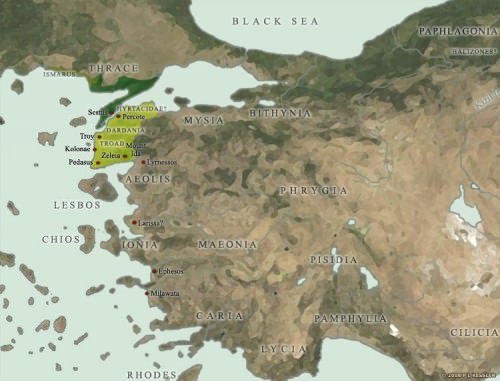
Map of the Trojan War States, c. 1200 BCE
Book 2 – Catalogue of Ships
Agamemnon rashly tries to storm Troy without Achilles, thus making himself even more unpopular with his men. There is a catalogue of ships which lists all the cities taking part in the war. It is long and impressive.
HELEN TO HECTOR: 'ON US TWO ZEUS HAS SET A DOOM OF MISERY, SO THAT IN TIME TO COME WE CAN BE THEMES OF SONG FOR MEN OF FUTURE GENERATIONS' (6:357)
Book 3 – The Revenge of Menelaus
'Godlike' Paris challenges Menelaus, 'master of the war-cry,' to a one-on-one fight to settle the war there and then. Helen bites her fingernails from the walls of Troy as Paris, wearing slightly flashy and inappropriate armour, is soundly beaten, but 'quick-glancing' Aphrodite steps in and whisks off the prince in a cloud. The war does not end this day.
Book 4 – Zeus Decides Troy's Fate
The gods argue about the progress of the war, but Athena and Hera insist that Troy must be destroyed. Zeus consents, but in return, he will destroy cities of his own choosing and at his own leisure - Mycenae will be one of them. Meanwhile, the two armies clash and the plains run with rivers of blood.
Book 5 – Apollo Repels Diomedes
The fighting continues, and the mighty Greek Diomedes kills all before him. The hero even attacks Aphrodite and Ares, but he finds himself no match for Apollo, the 'far-shooter,' in a scene which reminds of the unbridgeable gulf between gods and men.
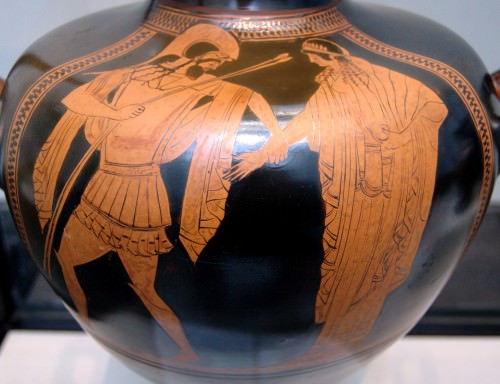
Menelaos & Helen
Book 6 – Humanity in War
The fighting on the plains continues and Diomedes meets Glaucus, but instead of fighting, these two champions have a chat and realise they are of mutual descent. They exchange some gifts of armour and part as friends, a little oasis of humanity in the pitiless desert of war. Meanwhile, inside Troy, we meet Hector's wife Andromache to remind us that the Trojans are not dissimilar to the Greeks and their women are equally worried for the future.
HECTOR: 'AND PEOPLE WILL SAY, EVEN MEN OF GENERATIONS NOT YET BORN, AS THEY SAIL BY OVER THE SPARKLING SEA IN THEIR MANY-BENCHED SHIPS: “THIS IS THE MOUND OF A MAN WHO DIED LONG AGO. HE WAS THE GREATEST OF MEN, & GLORIOUS HECTOR KILLED HIM”.' (7:71)
Book 7 – Hector vs. Ajax
Hector, 'tamer of horses,' son of king Priam and greatest Trojan warrior, challenges any Greek to combat. Agamemnon persuades Menelaus not to accept, and instead, Ajax, having drawn lots for the honour, marches out to meet the prince. The pair clash but without a decisive blow, and Ajax proves the master. Darkness then calls a halt to the fight and they part, once again loaded down with gifts. The next day a truce is called so that the dead can be gathered and cremated.
Book 8 – Hector Drives the Greeks Back to their Camp
Slightly fed up that the war has not ended by now, Zeus absolutely forbids the gods to intervene this day. Hector is magnificent and leads his army in a rousing charge which pens the Greeks back behind their fortified camp by the shore. Hector camps his army outside the city, such is his confidence in total victory the next day.
Book 9 – Achilles Refuses Agamemnon's Appeal
Things look so bad that Agamemnon considers throwing in the towel and sailing home, but he is persuaded to try and tempt Achilles to rejoin the fight by offering him a mass of treasure. Odysseus (wily king of Ithaca and especially smooth talker) leads Phoenix and Ajax who all tell Achilles to think of the men, their suffering, and the glory he can win. Achilles refuses and now loses the moral high ground. His pride will cost many lives.
Book 10 - Reconnaissance
A sort of intermission where both sides hold a meeting and decide to send spies into the enemy camp to check out their positions and weaknesses.
Book 11 – The Battle Ebbs & Flows
The Greeks come out of their camp fighting as never before and drive the Trojans back to Troy, but then the tide swings and the Greeks are forced to retreat with many wounded, including Agamemnon and Odysseus.
ARES GOD OF WAR: 'CALLED TERROR & PANIC TO YOKE HIS HORSES WHILE HE HIMSELF PUT ON HIS GLEAMING ARMOUR' (15:113)
Book 12 – The Greek Camp is Breached
The Trojans, with Hector and Sarpedon leading the way, break down the walls and smash the gate of the Greek camp. The Greeks panic and flee for their ships.
Book 13 – Poseidon Intervenes
The Greeks receive the help of Poseidon, the 'Earth-Shaker,' and they drive back the Trojans, wounding many and killing even more, including Ascalaphus, the son of Ares no less.
Book 14 – Hera Seduces Zeus
To keep the momentum with the Greeks, Hera, with the help of Aphrodite, distracts and seduces Zeus on Mt. Ida. Hector, meanwhile, is injured by a rock thrown by the now less-than-friendly Ajax.
Book 15 – Hector's Finest Hour
Zeus awakens to see the Trojans in peril and forbids any more intervention from Poseidon. Apollo joins the fighting, and with his help, the Trojans once more drive the Greeks back into their camp. Hector, enjoying his best day of the war, leads his men to the ships and calls for fire to set them all ablaze.
NARRATOR: 'AS HE SPOKE THE END OF DEATH ENFOLDED HIM: & HIS SPIRIT FLITTED FROM HIS BODY & WENT ON THE WAY TO HADES, WEEPING FOR ITS FATE.' (16:855)
Book 16 – Death of Patroclus
A key book. Patroclus, best friend of Achilles, remembers the advice of Nestor and begs the great warrior to join the fighting and, if not, then allow him to lead the fearsome Myrmidons wearing Achilles' armour. Achilles consents and the fate of his friend and his own is now sealed. The Myrmidons manage to put out the fire amongst the ships, and Patroclus even kills Sarpedon but then rashly charges the Trojans back to Troy. Apollo intervenes and strikes the hero's armour from his body, and he is killed by the spear of Hector. Now Achilles will be really angry. Troy's fate is also sealed this day.
Book 17 – The Body of Patroclus
The two sides fight for the body of Patroclus, but the Trojans win and strip his body. Hector dons the armour of Achilles, but the Greeks renew their efforts and finally manage to take the naked corpse back to their camp for proper burial.
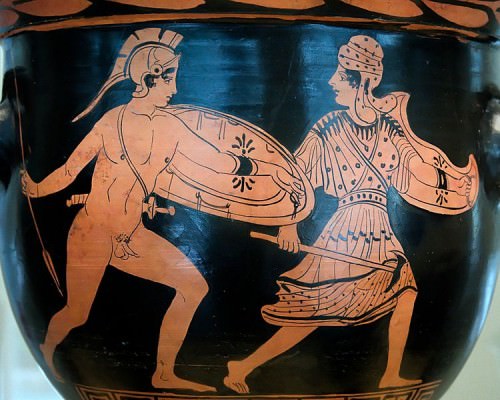
Achilles & Penthesileia
Book 18 – The Armour of Achilles
Achilles is told of the death of his friend and is predictably livid. He swears revenge on Hector. To fight, though, he needs armour, and this is promised him by his mother Thetis who enlists the master craftsman god Hephaistos. There follows a lengthy description of Achilles' new shield which is decorated with a myriad of fantastic scenes.
Book 19 – Achilles' Death is Foretold
Agamemnon and Achilles are reconciled and everyone has a big feast before the big battle of the 'morrow. Achilles knows now that he will die, and it will be at the hands of Paris and Apollo, but revenge drives him on undeterred.
APOLLO: '...WRETCHED MORTALS, WHO ARE LIKE LEAVES – FOR A TIME THEY FLOURISH IN A BLAZE OF GLORY, & FEED ON THE YIELD OF THE EARTH, & THEN AGAIN THEY FADE LIFELESS' (21:462)
Book 20 – The Gods Take Sides
Zeus calls for the gods to take their places in the coming battle. Ares, Artemis, Aphrodite, and Apollo will aid the Trojans while the Greeks have Hera, Poseidon, Hermes, and Athena. Battle commences on the plains. Achilles sweeps all before him, but Hector is saved from a confrontation by Apollo who whisks him away in a cloud.
Book 21 – Achilles & Xanthos
Achilles is still chopping away at the Trojans and bags himself 12 captives to slaughter later at the funeral of Patroclus. He drives so many of the enemy into the river Xanthos that the river god rises in indignation and chases Achilles back to the Greek camp. The gods begin fighting each other in a painless and inconsequential parody of the more brutal battle on the plain. Meanwhile, the Trojans are driven back, and all flee into their city, all except one: Hector, who makes a stands at the Skaian Gates.
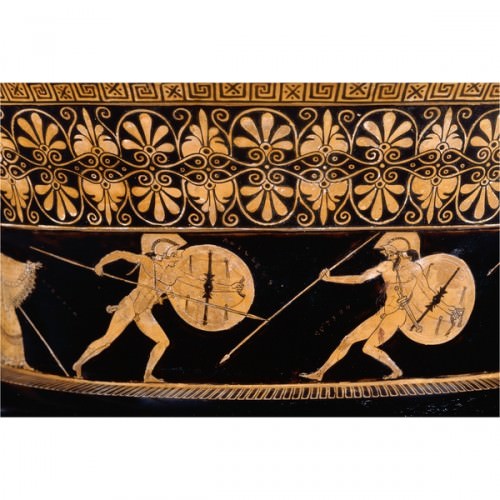
Achilles Fighting Hektor
Book 22 – Achilles vs. Hector
Hector, blaming himself for his own stupidity and camping out on the plains instead of safely inside the city walls, prepares to meet his fate. Priam bites his fingernails from the walls of Troy as he sees Achilles approach in his gleaming armour. The sight of the great warrior speeding towards him causes Hector to flee, and the pair indulge in a chase around the city three times.Zeus then weighs the golden scales of Fate and Hector's side sinks. 'Swift-footed' Achilles catches his man and sends him to Hades with a single spear strike to the throat. Now Troy really is in trouble. Shockingly, Achilles ties the body of Hector to his chariot and drags him ignominiously back to camp.
ACHILLES: 'THIS IS THE FATE THE GODS HAVE SPUN FOR POOR MORTAL MEN, THAT WE SHOULD LIVE IN MISERY, BUT THEY THEMSELVES HAVE NO SORROWS' (24:525)
Book 23 – Funeral Games for Patroclus
Having got his revenge, Achilles now sets about honouring Patroclus with some funeral games which include chariot races and prizes for all the winners. It is a break for everyone before the emotional drama of the final book.
Book 24 – Priam's Appeal
The gods are angry at Achilles' disrespect for the body of Hector. Thetis is sent to appeal to him. At the same time, Priam is helped by Hermes to magically appear in the Greek camp on his own mission of mercy. Achilles bows to Priam's moving speech and releases the body of Hector for proper burial. Here the Iliad ends.
What Happens Next
The demise of Hector is Homer's metaphor for the fall of Troy itself as the Iliad 's story ends here, if not the actual war. We still have to come battles with Amazons and the death of Achilles, felled by an arrow to his heel from Paris' bow. Paris is shot by Philoctetes, and Ajax goes mad and slaughters a load of sheep before committing suicide after not getting the armour of Achilles. Then, after the Trojan Horse ruse to gain entry into the city, Troy finally falls and is ruthlessly sacked.
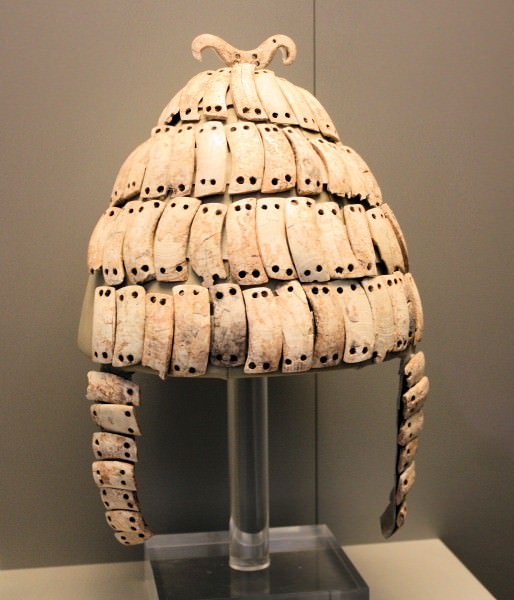
Mycenaean Boar's Tusk Helmet
MYTH & REALITY
The archaeological site of Troy in Anatolia, first excavated by Heinrich Schliemann in the late 19th century CE, has revealed a city with a history of habitation over thousands of years. Of the several cities built on top of each other, Troy VI (c. 1750-1300 BCE) is the most likely candidate for the besieged city of the Iliad. Impressive fortification walls with several towers certainly fit the Homeric description of 'strong-built Troy.' The lower town covers an impressive 270,000 m² and suggests a grand city like the Troy of tradition. Bronze arrowheads, spear tips, and slingshots have been found at the site and even some embedded in the fortification walls, suggesting some sort of conflict. These date to around 1250 BCE which correlates with the traditional date for the Trojan War.
Conflicts over generations between the Mycenaean and Hittite civilizations are more than probable, colonial expansion and control of lucrative trade routes being prime motivators. While such conflicts are unlikely to have been on the scale of Homer's war, collectively, they may well have been the origin of the epic tale of the Trojan War which has fascinated for centuries.
LICENSE:
Article based on information obtained from these sources:with permission from the Website Ancient History Encyclopedia
Content is available under License Creative Commons: Attribution-NonCommercial-ShareAlike 3.0 Unported. CC-BY-NC-SA License